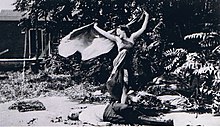| The Vampire | |
|---|---|
 Alice Eis and Bert French performing the "Vampire Dance" Alice Eis and Bert French performing the "Vampire Dance" | |
| Directed by | Robert G. Vignola |
| Written by | T. Hayes Hunter Robert G. Vignola |
| Starring | Alice Hollister Harry F. Millarde |
| Cinematography | George K. Hollister |
| Production company | Kalem Company |
| Distributed by | General Film Company |
| Release date |
|
| Running time | 38 minutes |
| Country | United States |
| Language | Silent film |
The Vampire is an American silent film drama, directed by Robert G. Vignola, based on the 1897 eponymous poem by Rudyard Kipling. It stars Alice Hollister and Harry F. Millarde. It is generally considered the first recognized film depicting the vamp character, also known as femme fatale.
Plot
Harold Brentwell moves to the city for a new job and meets Sybil, an adventuress. Harold is totally fascinated by Sybil and forgets his fiancée Helen but, actually, Sybil is a vampire who is going to ruin his life. He soon loses his job and becomes an alcoholic. Abandoned by the vamp, desperate and alone, Harold goes to the theater and watches the "Vampire Dance", depicting a man dominated by a beautiful woman who, eventually, takes his life putting the bite on him. Thus Harold understands his weakness and tries to redeem himself.
Cast
- Alice Hollister as Sybil the Vampire
- Harry F. Millarde as Harold Brentwell
- Marguerite Courtot as Helen
- Henry Hallam as Martin
- Bert French and Alice Eis as the dancers
- Robert G. Vignola (uncredited)
Production

The Vampire was shot in Cliffside Park, New Jersey.
The highlight of the production is the presence of dancers Alice Eis and Bert French performing their "Vampire Dance", inspired by Philip Burne-Jones painting The Vampire (1897). A still of the performance recreates the exact features of the painting. "The Vampire Dance" was famous and controversial at the time in the American vaudeville circuit for its provocative poses, before it was documented as part of the film.
On February 20, 1913 the dancers scandalised authorities with their number "Le rouge et noir" and were arrested on obscenity charges the next day, later freed on $500 bail each. Eis and French were paid $2,000 by the Kalem executives to immortalise the "Vampire Dance".
Reception
The New York Dramatic Mirror wrote: "The acting of Miss Hollister as the adventuress in handling the different situations with the hero stands out. The director has carried detail to a fine point and very artistically. Photography good."
The Moving Picture World stated: "It is well acted and in photography is, for the most part, above criticism."
Preservation status
Previously considered to be a lost film, a print exists in the George Eastman Museum film archive. It is cited as the oldest existing "vamp" movie.
An earlier film, The Vampire (1910), starring Margarita Fischer and produced by William Nicholas Selig is considered lost.
See also
References
- John T. Soister, American Silent Horror, Science Fiction and Fantasy Feature Films, 1913-1929, McFarland, 2012, p.41
- Amber Butchart, The Fashion of Film, Hachette UK, 2016, p.100
- Paolo Cherchi Usai, Silent Cinema: A Guide to Study, Research and Curatorship, Bloomsbury Publishing, 2019, p.126
- ^ James Card, Seductive cinema: the art of silent film, Knopf, 1994, p.183
- Andrew L. Erdman, Blue Vaudeville: Sex, Morals and the Mass Marketing of Amusement, 1895-1915, McFarland, 2015, p.120
- "Fortune dancers arrested" (PDF). timesmachine.nytimes.com. February 21, 1913. Retrieved June 8, 2019.
- Jonathan Rigby, American Gothic: Sixty Years of Horror Cinema, Reynolds & Hearn, 2007, p.21
- Jay Leyda, Charles Musser (1986). Before Hollywood: Turn-of-the-Century Film from American Archives. American Federation of Arts. pp. 152. ISBN 9780917418815.
- Licensed Specials. The Moving Picture World. 1913. pp. 496.
- "The Vampire". silentera.com. Retrieved October 1, 2017.
- Tom Pollard (2016). Loving Vampires: Our Undead Obsession. McFarland. p. 50. ISBN 9781476624303.
External links
- The Vampire at IMDb
- 1913 films
- 1913 drama films
- 1910s American films
- 1910s English-language films
- 1910s rediscovered films
- American black-and-white films
- American silent short films
- Films based on poems
- Films based on works by Rudyard Kipling
- Films directed by Robert G. Vignola
- General Film Company
- Kalem Company films
- Rediscovered American films
- Silent American drama short films
- Surviving American silent films